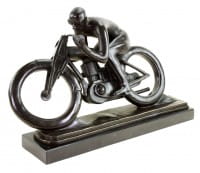Otakar Švec
Otakar Švec was a renowned 20th-century Czechoslovakian sculptor, best known for his busts and monuments of famous personalities. Born in Prague on March 13, 1892, Švec died in the same city on April 2, 1955.
Švec studied at the School of Applied Arts in Prague, and later at the Prague Academy of Fine Arts under the guidance of Professor Jan Štursa. He was a skilled artist, known for his precise, often realistic depictions.
Perhaps his most infamous work is the monumental Joseph Stalin monument, revealed in 1955, the year of his death, on Letná Hill in Prague. The monument was the largest group statue in the world at that time, but its artistic merit was a topic of debate, particularly considering the repressions and human rights violations that occurred under Stalin's regime.
The Stalin monument was ultimately demolished during the Prague Spring in 1962, but it left a lasting impression on Czech history and consciousness. Švec tragically ended his own life, only days before the grand unveiling of the monument.
His other notable works include a bust of Thomas Garrigue Masaryk, the first President of Czechoslovakia, as well as monuments of Czech composer Bedřich Smetana and Czech writer Alois Jirásek. His sculpture of Karel Hynek Mácha, a leading poet of Czech Romanticism, is another significant piece.
In recent years, Švec's fate has sparked renewed interest in his work and life. Despite the controversies surrounding his work, Švec remains a compelling figure in the history of Czechoslovakian art.
Otakar Švec's artistic style was characterized by a careful attention to detail and an ability to capture the essence of the individuals he portrayed. Although his works were typically realistic, he also integrated elements of Symbolism and Expressionism into his creations.
Švec worked across a variety of mediums. While primarily known for his sculptures, he was also a talented draftsman and frequently used his drawings as a basis for his sculptural works.
His career was unfortunately marked by political controversies that often overshadowed his artistic achievements. The Stalin monument, for example, was not only a massive technical undertaking but also deeply divisive. The construction process took over five and a half years and involved the efforts of hundreds of workers. The monument was ultimately destroyed seven years after its unveiling due to the destalinization period that followed Stalin's death.
Švec's tragic death, just days before the unveiling of the Stalin monument, has often tinted perceptions of his body of work. The monument, despite its eventual destruction, remains an integral part of Czech history. The pedestal where the statue once stood now houses a large metronome, installed in 1991, serving as a stark reminder of the site's history.
Despite the controversy surrounding the Stalin monument, Otakar Švec remains a significant figure in the history of Czechoslovakian art. His works can be seen in various museums and collections in the Czech Republic and continue to inspire and challenge viewers today.

